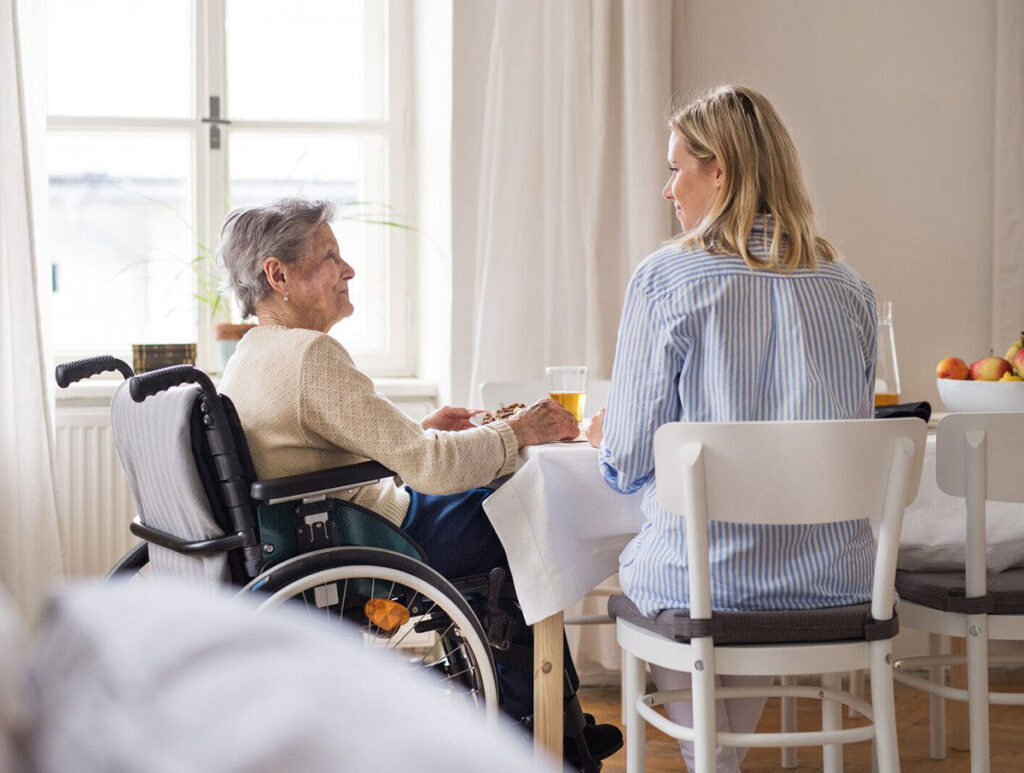Usually, dom care staff are adequately trained and Disclosure and Barring Service (DBS) tested by the United Kingdom government. The essence of the check is for maximum safety and assurance that the staff has no criminal record or ban.
Some organisations oversee and check home care facilities to ensure that services measure up to the law’s requirements and health standards. Every country in the United Kingdom has its regulatory body, and they visit these facilities to conduct intensive checks.
It is the job of care supervisors to pair carers with patients. The pairing occurs based on the geographic region, availability, and individuality. And they perform a needs assessment before the pairing exercise. The evaluation involves visiting the patient to inquire what assistance they would need.
Visitations for daily care are between half an hour to one hour. The visits can happen as many times as possible in one day. The patient can choose to have visits for more extended periods. This kind of visit is known as “sitting” or “sit”, and it involves the worker helping out with household chores, day-to-day activities, sightseeing, etc.
Usually, “sitting” have a different pattern of operation, such that the staff takes turns visiting. The workers also regulate and administer drugs to the person. They can be three or four in number. This helps to build closeness and trust over time.
Types of Domiciliary Care
There are different types of domiciliary care available for patients, and they are explained below.
Companionship Care
Companionship care is offered to people of old age who are alone or close to solitary. These categories of people are not sick or dependent on support for their chores. They do not want to be put in care facilities or a remote area to reside. They need someone to be with and communicate with often for their happiness and mental state.
According to studies, loneliness affects many individuals in the United Kingdom. In-house and external companionship helps their confidence and boosts their social skills. More so, it allows them to stay out of depression.
Personal Care
Personal care involves assistance with day-to-day personal chores that might be hard to carry out due to illness or old age. Some of these chores include shaving, using the lavatory, dressing up, washing, etc. For people with locomotive dysfunction, the care staff use hoists and sliders to change their positions and locations. The individual has to choose what kind of service they want and the service schedule. More so, domiciliary personal care service is often done, holding the patient in high regard.
Dementia Care
Research shows that there are over 845,000 individuals in the United Kingdom who have dementia. The condition happens in different ways, like Frontotemporal Lobar Degeneration and Alzheimer’s disease. Dementia care, as a form of domiciliary care, helps them to live routinely and sustain their social lives. During this period, the personnel help them with personal and home duties and help them to have an independent life.
Care staff also help them handle challenging behaviour and treat them as ordinary people. By doing so, they will know the conditions they are suffering from and how to support them. This care is instrumental for dementia caused by alcohol and young-onset dementia because people with these illnesses may not know that domiciliary care is what they need.

Live-in Care
Live-in care is a home care service, and it is for people who need company and care at home. These kinds of people usually live in large houses with a lot of space. While it is not for everyone, it has several benefits and drawbacks. This type of domiciliary care allows the cared person to receive personal care and house maintenance.
The person can continue living their everyday lives as they want. They can maintain their quality and preference of living, pets, and social life while receiving some help as their needs change. However, a disadvantage of this type of care is that the person will not have their privacy as they want it. Nonetheless, if the care personnel have high regard for the patient and the house rules, there should be no worries about privacy.
Another advantage of this kind of domiciliary care is that the cared person and the care staff can have a cordial and fruitful relationship. Since the staff is like a home mate, it is possible to achieve this closeness. Hence, the cared person has to select one or two workers they feel compatible with. More so, the staff must undergo all checks, including an updated Disclosure and Barring Service test (DBS), to be sure that they have authorisation.
Although this kind of care is productive, it can be costly. As expected, the staff will need to have a separate quarter. This quarter has to be in good shape and have basic conveniences like a good loo and bathroom, access to the internet, a telly, a good bed, etc. It is also necessary that the patient’s house is excellent and comfortable enough to accommodate the care staff. And refurbishing a room to meet this standard can be expensive.

Respite Home Care
This kind of care is given temporarily. Sometimes, workers render it as an assistance to full-time carers. It is to help the primary carer take some time off their duties to attend to personal needs. This kind of respite care can be offered weekly or daily so the main care personnel can fix some things and prepare for the next working period.
Respite staff are well trained to effectively fill up the space of the primary worker and perform almost as perfect as the primary caregiver. More so, they are trained to adapt to almost every kind of working environment they find themselves in.
Another kind of respite care is for people who are just discharged from the hospital and need some assistance while they recuperate. Domiciliary care workers can render this kind of service to people of all ages. It involves support with carrying out daily duties and administering drugs and injections.
Shared Lives
This kind of domiciliary care is where the individual who needs care leaves their home to visit or live with a caring staff. It creates room for new family integration and interaction during their care periods. The care period can be for a short while. For instance, a young individual who just left the hospital may need a hospitable abode so they can recover to independence.
Shared lives can also be administered for a long time. Long-term shared lives services are mainly administered to aged people or people who have long-term health conditions. Shared lives care is similar to care facilities, such that the person learns a new lifestyle, practices new skills, and becomes self-dependent. They are exposed to new events and opportunities as they stay with other people. As time goes on, they begin to find value in the home, thus improving their mental health and self-pride.
Shared lives staff are trained and examined by their organisations to ensure that they are fit and professional enough to do their jobs. These staff members receive benefits for caring for people in their houses, like monetary payments. For some, it gives them a chance to stay out of loneliness, while for others, it is an opportunity to assist other people.
Nursing Care
Though most care staff are trained to perform several medical jobs like dressing wounds and administering drugs, some medical duties will require the assistance of a professional nurse. So, often there are authorised nurses to perform this kind of care. These nurses visit the patient at home and conduct every nursing care professionally. They offer services including treating skin issues like pressure injuries and skin tears, cleaning and treating deep wounds, administering injections and drugs.
When necessary, they offer assistance for surgical treatments like tracheostomy and stomas and catheters.

